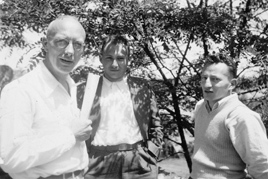|
XII: Nucleic Acids and Nucleoproteins 1947 |
|
|

|
From left: Dr. E. Tatum, Dr. Joshua Lederberg, Dr. Sol Spiegelman SYMPOSIUM SYNOPSIS LIST OF PARTICIPANTS CONTENTS OF SYMPOSIUM VOLUME PHOTOGRAPHS PUBLISHED VOLUME  |
Nucleic Acids and Nucleoproteins
11–20 June, 1947
Symposium Synopsis
Organizer: Milislav Demerec
Demerec chose this topic to complement the IXth and XIth Symposia. That nucleic acids and nucleoproteins might be constituents of genes had been known since 1923, when Feulgen used his staining technique for DNA to show that they were components of chromosomes. The next development—the nucleoprotein theory of the gene—arose in the 1930s when Caspersson showed, using ultraviolet microscopy, that the amount of DNA increased markedly during meiosis, a time when the chromosomes were believed to duplicate. However, in 1947, it was still generally thought that proteins were more likely to be the carriers of heredity information, despite Avery's work on transformation published in 1945.
Some did follow Avery, and AndrŽ Boivin's paper on "directed mutation" is remarkable, concluding: "Thus, this amazing fact...is reduced in the last analysis (his emphasis) to innumerable modifications within the molecular structure of one single fundamental chemical substance, nucleic acid..." However, the general consensus, as expressed forcefully by Mirsky, was that Boivin's assertions went going beyond the experimental facts. Not surprisingly, Chargaff, who changed his research program in response to Avery's results was more appreciative, writing that "The epochal experiments of Avery and his associates...have emphasized the very important role played by some bacterial nucleic acids..." He presented his methods for the isolation of high molecular weight DNA.
The volume opens with a tribute to John Masson Gulland, the English nucleic acid chemist who had been killed in a train crash on 26 October, just four months after he had participated in the Symposium. (Manchester, K. Did a tragic accident delay the discovery of the double helical structure of DNA? Trends Biochem. Sci. 20: 126-128, 1995). The work discussed in this paper—Gulland's evidence from electrometric titrations of DNA that the bases were joined by hydrogen bonds—played an important part in substantiating the double helix. As Watson put it, "...a rereading of J. M. Gulland's and D. O. Jordan's papers...made me finally realize the strength of their conclusion that a large fraction, if not all, of the bases formed hydrogen bonds to other bases."
Search images: